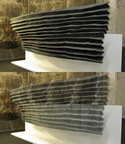February 21, 2007
SplineGraft - Krets

Controlled by a Genetic Algorithm
The SplineGraft project sets up a reactive environment in which sound dampening panels are continuously reshaped by a network of actuating devices, triggered by user movement. The panels are grafted into an existing environment, supported by structural racks allowing a range of different configurations. The SplineGraft can be set in different overall shapes independent of its behavior. The different parts are grafted onto each other; the profiled polyurethane panels are articulated by the configuration of the structural racks. The texture of this primary form is reshaped in real time by the control system integrated in the structural racks; a continuous form finding process with emergent patterning effects. In return, the spline ridges of the panels disperse these transformations horizontally.

Structure
The supporting structural racks are assembled from cnc-milled clear acrylic units, each integrating the actuating mechanisms, milled tracks for cabling and etched nickel brass conduits for inter-unit connectivity. The angle between each structural component can be set in five different positions, allowing the rack to be set at a convex or concave configuration, while maintaining conductive links between each part. Each rack of five units is controlled by a micro controller, steering the integrated actuators in the form of dual shape memory alloy wires. The central intelligence of each rack communicates with neighboring racks through radio.

SplineGraft behavior
The behaviour of the SplineGraft is controlled by a genetic algorithm; a computer program that simulates and compresses the geologically slow processes of natural selection to nanoseconds of computational time, in order to evolve solutions to specific problems. The Spline Graft algorithm is in this way trying to emit patterns of movement which stimulate occupation of the space it has been grafted in to. The matching of sensor readings and motor reactions in an apparently intentional way by the Spline Graft, transforms architecture into a cybernetic agent involved in the making and production of space.

SplineGraft materials
CNC-milled acrylic structural components with integrated wiring, machined polyurethane foam, etched nickel brass conductors, IR Movement Sensor, custom made PCB Cards, AVR Atmega8 Microcontrollers, Radio Modules, diverse electronic components, Flexinol® shape memory alloy actuators with protective Teflon tubes. SplineGraft was developed by Krets partners Pablo Miranda and Jonas Runberger. A full list of credits are available on the project website.
My thanks to Chris aka Pixelsumo for the tip. [blogged by Ruairi on Interactive Architecture dot Org]
Posted by jo at February 21, 2007 12:51 PM
